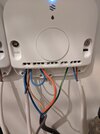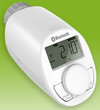- Joined
- 28 Aug 2022
- Messages
- 4
- Reaction score
- 0
- Country

Hi All
I'm trying to replace Honeywell thermostats with Nest. I don't do this professionally (something similar-ish) but have a fair amount of experience. The wiring centre is simple, Neutral, Live and Earth and six wires from three existing thermostats (two each).
I think the valves are Honeywell V4043H, and it's only "think" as the labels have been removed, so it has just been a case of matching them visually. They have 5 wires each:
Green
Brown
Blue
Orange
Grey
The manual for the V4043H, only has example wiring, but I tried (in brackets is what I connected them to on the Nest)
Green -> Earth (Earth)
Brown -> 3 (Call for Heat)
Blue -> N (Neutral)
Grey -> L + 2 (Common)
Orange - > Nothing
With that, the Nest won't open the value (the mechanical lever is just loose). Strangely, when the call for heat stops, the value tries to close (even though it's already closed).
There's only a certain number of combinations; trial and error is tempting but risky
Long shot, has anyone got any suggestions or is familiar with this type of valve?
Thanks in advance
* The attached picture shows the wire colours - it's another wiring I've tried, which seemingly does nothing!
I'm trying to replace Honeywell thermostats with Nest. I don't do this professionally (something similar-ish) but have a fair amount of experience. The wiring centre is simple, Neutral, Live and Earth and six wires from three existing thermostats (two each).
I think the valves are Honeywell V4043H, and it's only "think" as the labels have been removed, so it has just been a case of matching them visually. They have 5 wires each:
Green
Brown
Blue
Orange
Grey
The manual for the V4043H, only has example wiring, but I tried (in brackets is what I connected them to on the Nest)
Green -> Earth (Earth)
Brown -> 3 (Call for Heat)
Blue -> N (Neutral)
Grey -> L + 2 (Common)
Orange - > Nothing
With that, the Nest won't open the value (the mechanical lever is just loose). Strangely, when the call for heat stops, the value tries to close (even though it's already closed).
There's only a certain number of combinations; trial and error is tempting but risky
Long shot, has anyone got any suggestions or is familiar with this type of valve?
Thanks in advance
* The attached picture shows the wire colours - it's another wiring I've tried, which seemingly does nothing!



